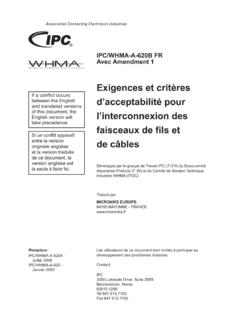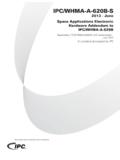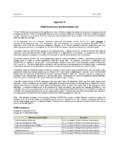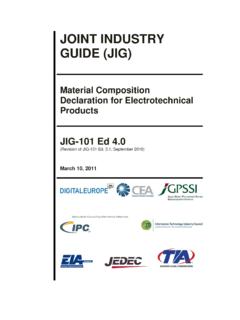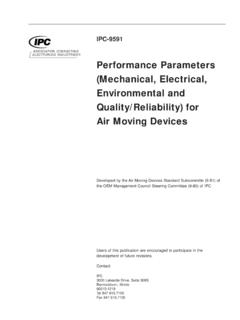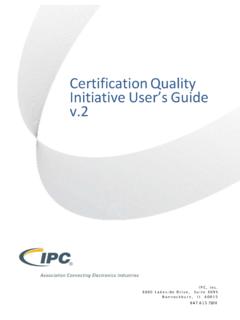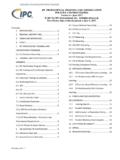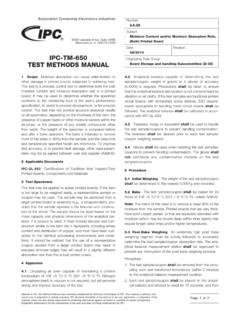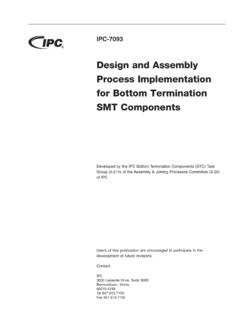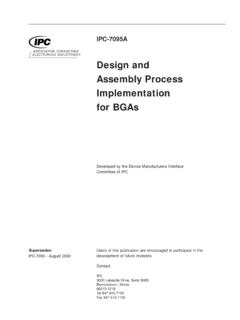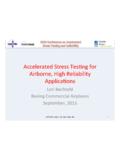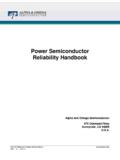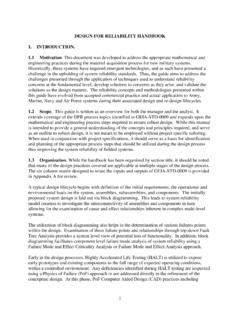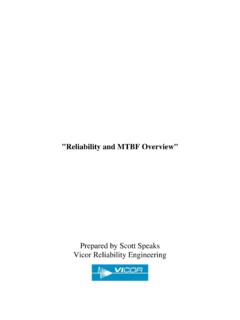Transcription of ELECTRONICS INDUSTRIES Performance Test …
1 IPC-9701A. ASSOCIATION CONNECTING. ELECTRONICS INDUSTRIES . Performance Test Methods and Qualification Requirements for Surface Mount Solder Attachments Developed by the SMT Attachment Reliability Test Methods Task Group (6-10d) of the Product and Reliability Committee (6-10) of IPC. Supersedes: Users of this publication are encouraged to participate in the IPC-9701 - January 2002 development of future revisions. Contact: IPC. 3000 Lakeside Drive, Suite 309S. Bannockburn, Illinois 60015-1219. Tel 847 Fax 847 February 2006 IPC-9701A. Table of Contents 1 SCOPE .. 1 Wearout Failures .. 5. Purpose .. 1 Statistical Failure Distribution Concepts .. 6. Performance Classification .. 1 Statistical Failure Distribution .. 6. Definition of Terms .. 1 Mean Fatigue Life, N(50%) .. 6. Failure Free Life, N0 .. 6. 2 APPLICABLE DOCUMENTS .. 1. Cumulative Failure Percentage .. 6. IPC .. 1 Cumulative Failure Probability .. 6. Joint Industry Standards .. 2 Acceptable Cumulative Failure Probability.
2 6. International Tin Research Institute .. 2 Reliability tests .. 6. Other Publications .. 2 Accelerated Reliability Test .. 6. electronic INDUSTRIES Association .. 2 Thermal Cycling .. 6. OEM Working Group .. 2 Thermal Shock .. 6. Power Cycling .. 6. 3 TERMS, DEFINITIONS AND CONCEPTS .. 2. Other tests .. 6. General .. 2. Burn-In Test .. 6. Reliability Concepts .. 2. Environmental Stress Screening (ESS) .. 6. Reliability Definition .. 3 Highly Accelerated Stress Testing (HAST) .. 6. Physics-of-Failure Concepts .. 3 Mechanical Shock .. 6. Creep .. 3 Vibration .. 7. Stress Relaxation .. 3 Process Qualification .. 7. Solder Creep-Fatigue Model .. 3 Process Verification .. 7. Differential Thermal Expansion .. 3 Evaluation and Application Considerations .. 7. Test Parameters .. 3 Understanding of Solder Attachment Technology .. 7. Working Zone .. 3. 4 Performance TEST METHODS .. 7. Cyclic Temperature Range/Swing .. 3. General Requirements .. 7. Sample Temperature: Ts.
3 5. Test Vehicles .. 7. Maximum Sample Temperature: Ts (max) .. 5. Component Description .. 7. Maximum Nominal Temperature: T (max) .. 5. Printed Wiring (Circuit) Boards .. 10. Minimum Sample Temperature: Ts (min) .. 5. Board Assembly .. 11. Minimum Nominal Temperature: T (min) .. 5. Accelerated Temperature Test Methods .. 12. Mean Cyclic Temperature, TSJ .. 5. Preconditioning by Isothermal Aging .. 12. Nominal T .. 5. Temperature Cycling .. 12. Dwell/Soak Time, tD .. 5. Test Monitoring .. 12. Dwell/Soak Temperature .. 5. Cycle Time .. 5 5 QUALIFICATION REQUIREMENTS .. 13. Temperature Ramp Rate .. 5 Thermal Cycling Ranges .. 13. Maximum Cyclic Strain Range .. 5 Thermal Cycling Test Durations .. 14. Maximum Cyclic Stress Range .. 5 Number of Samples .. 14. Hysteresis Loop .. 5 Test Exemption Requirements .. 14. Design Service Life .. 5 6 FAILURE ANALYSIS .. 14. Projected Service Life Service .. 5 Failure Analysis Procedures .. 14. Infant Mortality Failures .. 5 Failure Analysis Documentation Random Steady-State Failures.
4 5 Requirements .. 14. iii IPC-9701A February 2006. 7 QUALITY ASSURANCE .. 14 Tables Responsibility for Inspection .. 14 Table 3-1 Product Categories and Worst-Case Quality Conformance Inspection .. 14 Use Environments for Surface Mounted ELECTRONICS .. 4. As Assembled Inspection .. 14. Table 4-1 Temperature Cycling Requirements .. 8. Thermal Cycling Inspection .. 15. Table 4-2 Daisy Chain Requirements .. 8. Failure Analysis Inspection .. 15 Table 4-3 Test Exemption Requirements .. 9. APPENDIX A .. 16 Table 4-4 Test Monitoring Requirements .. 13. Table A-1 Values for Exponent m'' for the Four APPENDIX B .. 18 Test Condition Levels and for Four Representative Product Use Conditions .. 17. Figures Table A-2 Mean Fatigue Lives for a Given Component Assembly for the Four Test Condition Figure 3-1 Representative Temperature Profile for Levels and for Four Representative Thermal Cycle Test Conditions .. 3 Product Use Conditions .. 17. iv February 2006 IPC-9701A. Performance Test Methods and Qualification Requirements for Surface Mount Solder Attachments 1 SCOPE Revision Level Changes Changes made to this revi- This specification establishes specific test methods to sion of the IPC-9701 include Appendix B which establishes evaluate the Performance and reliability of surface mount guidelines for thermal cycle requirements for Pb-free sol- solder attachments of electronic assemblies.
5 It further der joints. Appendix B provides additional recommenda- establishes different levels of Performance and reliability of tions to existing IPC-9701 section requirements when uti- the solder attachments of surface mount devices to rigid, lizing a Pb-free soldering process. flexible and rigid-flex circuit structures. In addition, it pro- vides an approximate means of relating the results from 2 APPLICABLE DOCUMENTS. these Performance tests to the reliability of solder attach- The following documents are applicable and constitute a ments for the use environments and conditions of elec- part of this specification to the extent specified herein. Sub- tronic assemblies. sequent issues of, or amendments to, these documents will become a part of this specification. Documents are grouped Purpose The purpose of this document is: under categories as IPC, Joint Industry Standard, ITRI, To provide confidence that the design and the EIA and others depending on the source.
6 Manufacturing/assembly processes create a product that is capable of meeting its intended goals. IPC1. To permit the analytical prediction of reliability based on IPC-T-50 Terms and Definitions for Interconnecting and a generic database and technical understanding. Packaging electronic Circuits To provide standardized test methods and reporting pro- IPC-D-279 Design Guidelines for Reliable Surface Mount cedures. Technology Printed Board Assemblies Performance Classification This specification rec- IPC-TM-650 Test Methods Manual2. ognizes that surface mount assemblies (SMAs) will be sub- ject to variations in Performance requirements based on Microsectioning end use. While Performance Classes are defined in IPC- Adhesion, Plating 6011, Generic Performance Specification for Printed Peel Strength, Metal Foil Boards, these Performance classifications are not specific Bond Strength, Surface Mount Land (Perpen- as to the required reliability. At this point in time, the reli- dicular Pull Method).
7 Ability requirements need to be established by agreement between customer and supplier. Bow and Twist Rework Simulation, Plated-Through Holes Definition of Terms The definition of all terms used Coefficient of Thermal Expansion, Strain Gage herein shall be as specified in IPC-T-50, except as other- Method wise specified in Section 3. Dielectric Withstanding Voltage, Printed Wiring Material Interpretation Shall,'' the imperative form of the verb, is used throughout this specification whenever a Physical (Mechanical) Shock, Multilayer Printed requirement is intended to express a provision that is man- Wiring datory. Deviation from a shall'' requirement may be con- Thermal Shock-Rigid Printed Boards sidered if sufficient data is supplied to justify the exception. Thermal Stress, Plated-Through Holes The words should'' and may'' are used whenever it is Vibration, Rigid Printed Wiring necessary to express non-mandatory provisions. Will'' is used to express a declaration of purpose.
8 '' IPC-SM-785 Guidelines for Accelerated Reliability Testing of Surface Mount Solder Attachments To assist the reader, the word shall'' is presented in bold characters. IPC-S-816 SMT Process Guideline and Checklist 1. 2. Current and revised IPC Test Methods are available on the IPC website ( ). 1.
